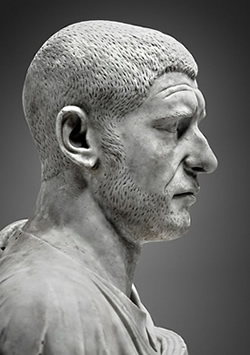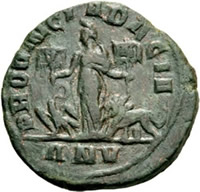Dacia introduction
The mint in the Roman province of Dacia struck coins very similar to the coins struck in the mint of Viminacium. Because of this similarity some scholars think that the coins bearing the legend PROVINCIA DACIA were struck in the mint of Viminacium. Because of differences in style, the spreading of the coins, the difference in the local dating on the coins and the known imperial chronology it recently is assumed that there must have been a mint somewhere in the province of Dacia itself. This mint probably was erected with help from personnel from the mint at Viminacium. The most logical choice for the location of the mint seems to be the town of Sarmizegetusa. The Roman colonia Ulpia Traiana Augusta Dacica Sarmizegetusa was built during the time of the emperor Traian some 40 km from the old Dacian capital Sarmizegetusa. It had grown into a very important Roman town and was the seat of the concilium Daciarum trium, the government of the three Dacia's. From here the three parts of Roman Dacia were governed (Dacia Porolissenis, Dacia Superior and Dacia Malvensis). Another place that could have been the location of the mint is the colonia Aurelia Apulensis (Apulum - Alba Iulia). Apulum was one of the biggest Roman towns in Dacia and the home of the legio XIII Gemina. Today the remnants of these places lie in modern Romania.
The coinage of the PROVINCIA DACIA coins started during the reign of the emperor Philip I (244-249). A reason for the coinage in Viminacium had been the elevation of the town to a Roman colony with the right to strike coins. Sarmizegetusa and Apulum however already were Roman  colonies so the reason to strike this type of coins in Dacia must have been a different one. The reason for this coinage are most probably the military actions against the Carpi. Just as the mint of Vimiancium the mint of Dacia must have been a military mint, responsible for the coinage of small change in the form of copper and brass coins. The mint of Dacia probably did not mint silver antoniniani as the mint of Vimanacium did but only minted copper and brass asses, dupondii and sestertii. The coins minted in the Dacian mint are easy to recognise. The reverse of the coins show a woman who probably is the personification of the province of Dacia. She usually is holding 1 or 2 army standards and sometimes also a typical Dacian sword, the falx (ensis falcatus). On her left side stands an eagle with his wings spread and a wreath in its beak. The eagle was the emblem of the legio V Macedonica which was stationed at Potaissa (todays Turda) from approximately 166 until 274. On her right side stands a lion
colonies so the reason to strike this type of coins in Dacia must have been a different one. The reason for this coinage are most probably the military actions against the Carpi. Just as the mint of Vimiancium the mint of Dacia must have been a military mint, responsible for the coinage of small change in the form of copper and brass coins. The mint of Dacia probably did not mint silver antoniniani as the mint of Vimanacium did but only minted copper and brass asses, dupondii and sestertii. The coins minted in the Dacian mint are easy to recognise. The reverse of the coins show a woman who probably is the personification of the province of Dacia. She usually is holding 1 or 2 army standards and sometimes also a typical Dacian sword, the falx (ensis falcatus). On her left side stands an eagle with his wings spread and a wreath in its beak. The eagle was the emblem of the legio V Macedonica which was stationed at Potaissa (todays Turda) from approximately 166 until 274. On her right side stands a lion  which was the emblem of the legio XIII Gemina which was stationed at Apulum (todays Alba Iulia). The reverse legend is always PROVINCIA DACIA. In the exergue on the reverse of the coins stands AN (ANNO) followed by a Roman numeral. This numeral stands for the local year in wich the coin was struck. The year I stands for the first year after the beginning of the coinage and covered the period of the first day of the beginning of the coinage until the same date in the following year. The year I can thus be indicated as 246/247. The year II as 247/248 and so on.
which was the emblem of the legio XIII Gemina which was stationed at Apulum (todays Alba Iulia). The reverse legend is always PROVINCIA DACIA. In the exergue on the reverse of the coins stands AN (ANNO) followed by a Roman numeral. This numeral stands for the local year in wich the coin was struck. The year I stands for the first year after the beginning of the coinage and covered the period of the first day of the beginning of the coinage until the same date in the following year. The year I can thus be indicated as 246/247. The year II as 247/248 and so on.
Also in the case of Dacia the precise date of the beginning of the local year is unknown. Setting the 1st of january as the starting date of the local year gives many problems with the known chronology of the emperors. Also april 1st, the date of the founding of the city of Rome, gives to many problems with this chronology. It seems likely that the beginning of the local year in Dacia also started somewhere between july 1st and august 1st as it did in Viminacium. It is highly possible that also this mint did not hold strict control over this date. The new local year on the coins could have been used a little bit later or a little sooner. It is also highly probable that old reverse dies could have been used in combination with newer obverse dies of successive emperors.
| ANNO: | Period: |
| I | july 246 - july 247 |
| II | july 247 - july 248 |
| III | july 248 - july 249 |
| IIII | july 249 - july 250 |
| V | july 250 - july 251 |
| VI | july 251 - july 252 |
| VII | july 252 - july 253 |
| VIII | july 253 - july 254 |
| VIIII | july 254 - july 255 |
| X | july 255 - july 256 |
| XI | july 256 - july 257 |
According to the Roman numerals of the local year in the exergue on the reverse of the coins the mint of Dacia produced copper and brass coins until the local year XI (256/257). In this web catalog many coins of the Dacian mint are displayed. Many more variants exist but could not yet been displayed by the lack of images of those coins.